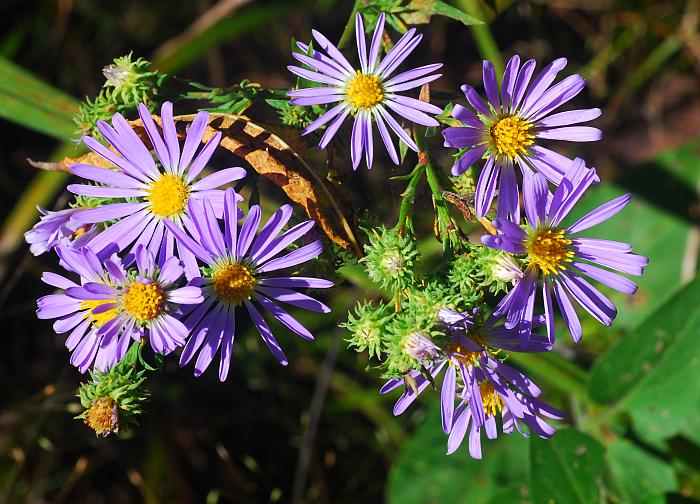Symphyotrichum anomalum (Engelm. ex Torr. & A. Gray) G.L. Nesom
Many-Rayed Aster

Native
CC = 6
CW = 5
MOC = 58
© SRTurner
Symphyotrichum anomalum (Engelm. ex Torr. & A. Gray) G.L. NesomMany-Rayed Aster | |
 |
Native CC = 6 CW = 5 MOC = 58 |
© SRTurner |
|
Family - Asteraceae/Astereae Habit - Perennial forb, usually from a short, stout, somewhat branched and sometimes woody rootstock, occasionally also producing elongate rhizomes. Stems - Ascending to erect, to 1 m, single or multiple, unbranched or with few to several ascending branches above the midpoint, relatively uniformly and moderately to densely roughened with short, spreading hairs, sometimes only sparsely so toward the base.
Leaves - Alternate, simple, petiolate. Basal and/or lower stem leaves present at flowering, long-petiolate, the petiole sometimes winged (often only toward the tip), the blade 4-10 cm long, 2.0-5.5 cm wide, heart-shaped, deeply cordate at the base, angled or tapered to a sharply pointed tip, the margins entire or slightly irregular, moderately to densely roughened with minute, stiff hairs on the upper surface, densely pubescent with slightly longer (still somewhat sandpapery) hairs on the undersurface, the secondary veins on the leaf undersurface faint or sometimes easily observed, often irregularly fused toward their tips, the veinlets often indistinct, forming a dense, irregular network of relatively short areoles. Median and upper stem leaves progressively smaller, with long to short, often winged but not clasping or sheathing petioles, the blades 1-6 cm long, heart-shaped to narrowly ovate (those along the inflorescence axis mostly lanceolate), cordate to truncate, rounded, or short-tapered at the base, otherwise similar to the lower stem leaves. Leaves of young plants velvety to the touch.
Inflorescence - Open panicles with relatively long, loosely ascending, racemose branches, sometimes with denser heads along the branches or reduced to a solitary, open raceme, the heads often appearing relatively long-stalked, the bracts along the ultimate branches 0.6-2.5 cm long, leaflike, linear to narrowly lanceolate, more or less grading into the foliage leaves.
Heads - Radiate, mostly 2.0-3.5 cm in diameter at flowering. Involucre 5-10 mm long, the bracts in 4-7 unequal, overlapping series, linear to narrowly lanceolate, relatively long-tapered at the sharply pointed tip, usually strongly recurved, the slender midvein broadened gradually in the apical 1/2-2/3 into a narrowly elliptic or narrowly diamond-shaped, green tip, this also sometimes purplish-tinged, the outer surface sparsely to moderately hairy, the margins moderately to densely hairy, especially toward the tip. Receptacle flat, naked.
Flowers - Ray florets 20-45 in 1 or 2 series per head, pistillate, the corollas well developed, 8-18 mm long, purple to blue. Disk 5-6mm broad. Disc florets 20-40, perfect, the corollas 4.0-5.5 mm long, the slender portion of the tube shorter than the slightly expanded apical portion, the lobes 0.4-0.6 mm long, 20-25 percent of the total length of the expanded portion. Pappus bristles 3.5-5.0 mm long, off-white to straw-colored or light tan, occasionally purplish-tinged. Stamens 5, adnate at the apex of the constricted portion of the corolla tube. Filaments translucent, 2 mm long, terete. Anthers yellow, 1.3 mm long, partially to entirely exserted, connate around the style. Style white, terete, glabrous, 5-6 mm long. Stigmas yellow, 1 mm long, not spreading, pubescent at the apex.
Fruits - Achenes 2-3 mm long, mostly with 5 or 6 longitudinal ribs, purplish brown with lighter ribs, glabrous. Flowering - July - November. Habitat - Glades, upland prairies, savannas, upland forests on rocky slopes, ledges and tops of bluffs, fencerows, roadsides. Origin - Native to the U.S. Lookalikes - Other purple-rayed species of Symphyotrichum, of which there are several. Other info. - This attractive aster is common in most of central Missouri, but rare or absent in the northwestern third of the state and the Bootheel. Missouri lies at the approximate center of the plant's natural range, which extends to only four other adjacent states. It is an easily recognized aster, with the combination of arrowhead-shaped leaves and strongly recurved involucral bracts being sufficient for identification. James Trager has suggested the clever mnemonic "Dr. Seuss" bracts to describe the distinctive curled phyllaries. Leaves (particularly of young plants) have a soft, velvety feel to the surfaces. The plant provides beautiful splashes of purple color to late summer and early fall woodland. It has been reported to hybridize with S. drummondii, S. oolentangiense, and S. shortii. Photographs taken in the Ozark Scenic Riverways, Shannon County, MO., 9-21-03 (DETenaglia); also at Shaw Nature Reserve, Franklin County, MO, 9-25-2009, Taum Sauk State Park, Iron County, MO, 9-27-2010, and Weldon Spring Conservation Area, St. Charles County, MO, 10-9-2011 and 9-23-2010 (SRTurner). |